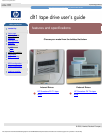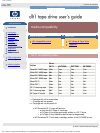
cartridges
hp learning products
http://www.hp.com/support/tape may have a later version
data protection
contact hp
home page
before you start
operation
cartridge care
cleaning
specifications
media compatibility
diagnostics
troubleshooting
FAQs
SCSI configuration
UNIX configuration
ordering supplies
cartridge care
contents of this section
related topics
choosing cartridges
caring for cartridges
using cartridges
storing cartridges
maximizing tape life
avoiding condensation
write-protecting cartridges
labeling cartridges
loading and unloading cartridges
ordering cartridges
choosing cartridges
Only rely on the best media to protect your valuable data. Thanks to HP's rigorous
testing programs, HP Surestore DLT1 data and cleaning cartridges are the safest
investment you can make.
HP DLTtape IV cartridges are designed to meet the exacting mechanical,
environmental and durability specifications of data storage applications.
Order online at: www.hp.com/go/storagemedia.
Important: You must use only DLT1 cleaning cartridges with HP Surestore DLT1
tape drives. Be aware that cleaning cartridges that do not specify DLT1 on the
cartridge may be accepted by the drive but will not clean the drive. Use only DLT1
cleaning cartridges.
Your HP Surestore DLT1 tape drive
uses only DLTtape IV cartridges. Your
DLT1 tape drive can read but not write
DLTtape cartridges that use the
DLT4000 format.
Make sure all cartridges that you want
to use for writing are either unformatted
or have been formatted with your DLT1
tape drive before loading them. If you
want to reuse cartridges that have been
formatted by a drive other than DLT1,
use a magnetic bulk eraser to prepare
the cartridges for use with your DLT1
tape drive.
caring for cartridges
Under optimum environmental conditions, Hewlett-Packard DLTtape IV cartridges
are currently specified to 1,000,000 passes over any part of the tape. In
operational terms, this can be translated to about 2000 full backup or restore
operations. Under severe environmental conditions, particularly where the tape
drive is used at very low humidity or if certain areas of the tape are accessed
frequently, the number of backup operations should be limited even further.
Caution: Ensure that only one label is located in the label area of the cartridge.
Never use non-standard labels and never stick anything to the cartridge.
using cartridges
Only use DLTtape IV cartridges in temperatures in the tape drive's operating
range from 10C to 40C (50°F to 104°F) and 20 to 80% relative humidity
(noncondensing). If you expose cartridges to temperatures outside the operating
limits, stabilize them before you use them. To do this, leave the cartridges in the
operating environment for 24 hours.
storing cartridges
Store cartridges at temperatures between 16°C and 32°C (60°F
and 90°F ) with a relative humidity between 20% and 80%.
Always keep the cartridges in a dust-free environment.
Always store cartridges in their plastic cases when not in use.
maximizing tape life
Do not touch the tape surface.
Do not attempt to clean the tape path or tape guides inside the
cartridge.
Do not leave cartridge tapes in excessively dry or humid
conditions.
Do not leave cartridges in direct sunlight or near sources of heat
or in places where magnetic fields are present (for example,
under telephones, next to monitors or near transformers).
Do not drop cartridges or handle them roughly.
Do not locate more than one label onto cartridges; extra labels
can cause the cartridges to jam in the tape drive.
Place identification labels only in the slide-in slot on the front of
the cartridge.
Never use any type of adhesive labels on your DLTtape cartridge.
avoiding condensation
Condensation can be a problem for tape drives and cartridges. To minimize the
chance of condensation, stay within the specifications for using and storing
cartridges above and observe the following guidelines:
1. Position the drive where the temperature is relatively stable -- away from
open windows, heat sources and doors.
2. Avoid leaving cartridges in severe temperature conditions, for example, in a
car standing in bright sunlight.
3. Avoid transferring data (reading from and writing to cartridges) when the
temperature is changing by more than 10°C (18°F) per hour.
4. If you bring a cold tape drive or tape cartridge into a warm room, allow time
for it to warm to room temperature before using it. For example, if you have
moved the drive from a cold car to a warm room, allow time for the drive to
reach room temperature (up to 24 hours if the temperature change is
extreme).
© 2000, Hewlett-Packard Company
file:///C|/Documents%20and%20Settings/topher.COL-SPRINGS/Desktop/manual/document/dlt1/user/reseller/eng/cart.htm [12/3/2001 7:50:30 AM]


















